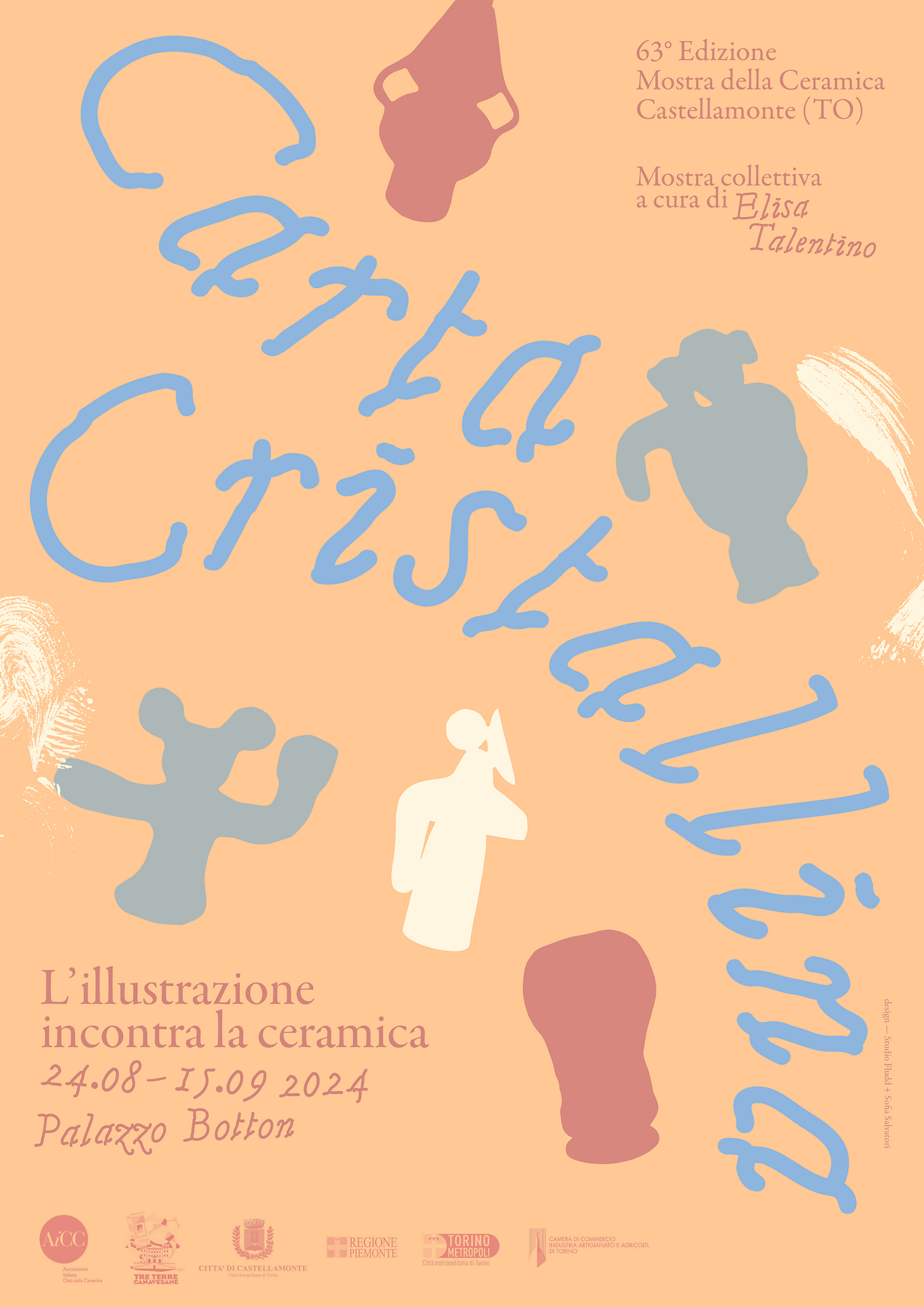Carta cristallina
L'illustrazione incontra la ceramica. Esposizione collettiva nel contesto della Mostra della Ceramica di Castellamonte
>>>Eng below
La ceramica è un tema che mi sta a cuore da tempi non sospetti: da ragazzina, quando si è trattato di scegliere il percorso di studi, non ho avuto dubbi sull’istituto d’arte a indirizzo ceramica presente nella mia città natale, Castellamonte.
È proprio su Castellamonte che voglio soffermarmi oggi: una cittadina nel territorio del Canavese a meno di un’ora da Torino e a pochi minuti da Ivrea (di quest’ultima potreste aver sentito parlare per il mondo Olivetti o forse per la battaglia delle arance dello storico carnevale).
A Castellamonte, nota per le sue stufe in ceramica esportate in tutto il mondo, a breve si terrà la 63° edizione della Mostra della Ceramica, manifestazione internazionale che riunisce opere di artiste e artisti da più di venti paesi.
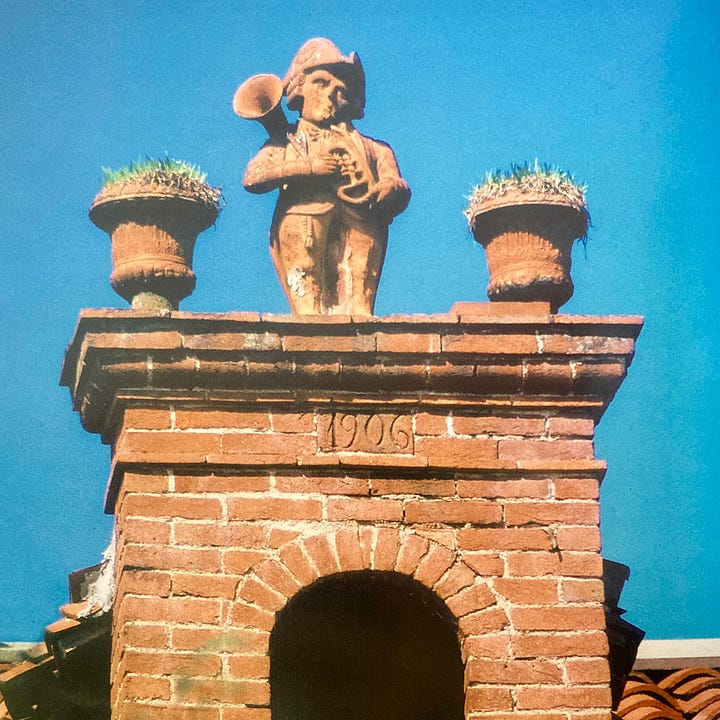
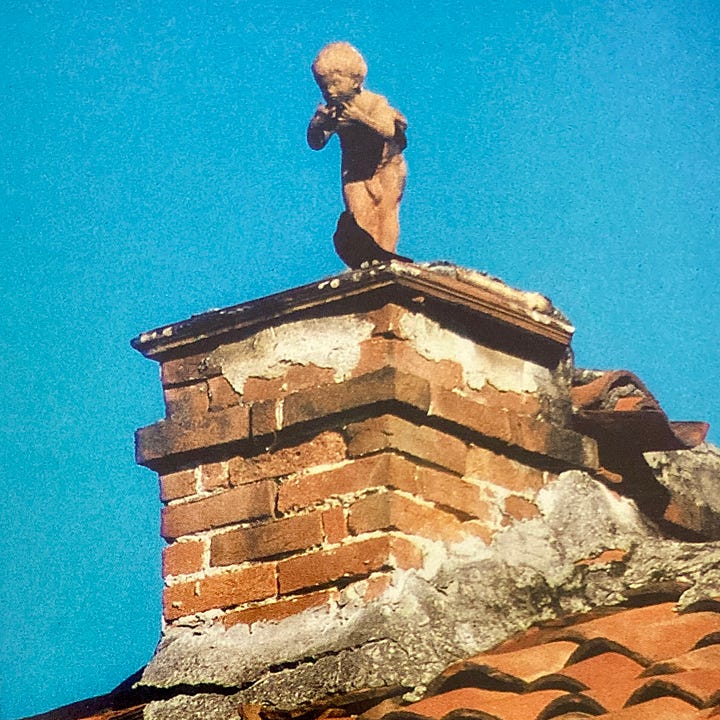
Quest’anno la storica manifestazione si apre al mondo dell’illustrazione; ho avuto il piacere di lavorare in veste di curatrice a Carta Cristallina: una mostra che coinvolge ventidue illustratrici e illustratori internazionali che annoverano la ceramica tra i propri mezzi espressivi. L’aspetto grafico e allestitivo è stato curato dalle poliedriche designer e progettiste di Studio Fludd, che hanno restituito aun’immagine eclettica e giocosa alla mostra.
Da qualche tempo avevo notato che la ceramica fosse oggetto di rinnovato interesse sopratutto nel mondo dell’illustrazione. Mi ero resa conto che sempre più illustratori, spesso nelle retrovie, realizzavano manufatti di una espressività e sintesi grafica sorprendente, come se il cambio di mezzo fornisse loro una freschezza e libertà d’espressione che l’esercizio quotidiano della professione non consentiva fino in fondo.
Un aspetto interessante è stato quello della sfida per l’artista nell’utilizzo di materiali diversi da quelli a cui si è abituati. I limiti tecnici che la ceramica per sua natura impone, obbligano l’illustratore a rivedere le proprie abitudini: le norme di lavorazione di terra, smalti e cottura, possono costituire un’occasione di sperimentazione nuova per il disegnatore; dall’ostacolo possono nascere approcci che danno vita a nuove cifre stilistiche.
E poi c’era l’aspetto della freschezza e dell’innocenza nell’approccio al mezzo: le ceramiche realizzate da illustratori, i quali hanno in genere competenze professionali lontane dalla maestria tecnica dei ceramisti artigiani, possiedono spesso una bellezza istintiva, archetipica, scevra nel bene e nel male dal condizionamento che le sovrastrutture tecniche impongono.
Hanno quella poesia della spontaneità che si ritrova per esempio in alcuni manifesti del maggio francese: in quel contesto gli artisti, servendosi della fantasia e di mezzi molto più semplici e modesti rispetto a quelli degli stampatori professionisti, crearono opere iconiche di una sintesi grafica straordinaria.
Tra i partecipanti spiccano nomi di artisti e illustratori di rilievo, che collaborano con le principali case editrici italiane o per riviste e quotidiani internazionali come The New Yorker o The New York Times: Mar Hernadez, Sarah Mazzetti, Anna Resmini, Alberto Fiocco ed Elena Xausa, artista eclettica dal segno essenziale scomparsa prematuramente che vogliamo ricordare in questa mostra (colgo l’occasione per consigliarvi di andare a sbirciare il Pigrotto, una scultura land-art che Lorenzo Fonda, il marito di Elena, ha fatto realizzare con un crowdfunfing partecipatissimo in sua memoria).
Tra gli ospiti internazionali appare la galiziana Nuria Figueiredo, con la sua ode alla natura, alla simbologia e al mistero, le portoghesi Mariana Santos, alias Mariana a Miseravel, Constança Duarte e Franpancispiscapa, con il loro sguardo fresco e ironico, tutte rappresentate da O! Galeria, con sede a Porto. Troviamo poi il collettivo spagnolo Boira Ceramics, la venezuelana Cristina Sitja Rubio, autrice di svariati albi illustrati pubblicati in più paesi e la boliviana Tami Izko, che ha preso parte a fiere internazionali come Artissima o la Biennale di Istanbul e che qui presenta con l’artista multidisciplinare Caterina Gabelli un progetto dal design organico e texture vibranti.






In mostra ritroviamo poi il lavoro di Alice Visentin, artista castellamontese che recupera ed eleva lo spirito dei cantastorie di un tempo, esplorando il tema dei riti contadini delle valli canavesane e che figura oggi tra gli artisti della Collezione permanente del Castello di Rivoli Museo d'Arte Contemporanea.
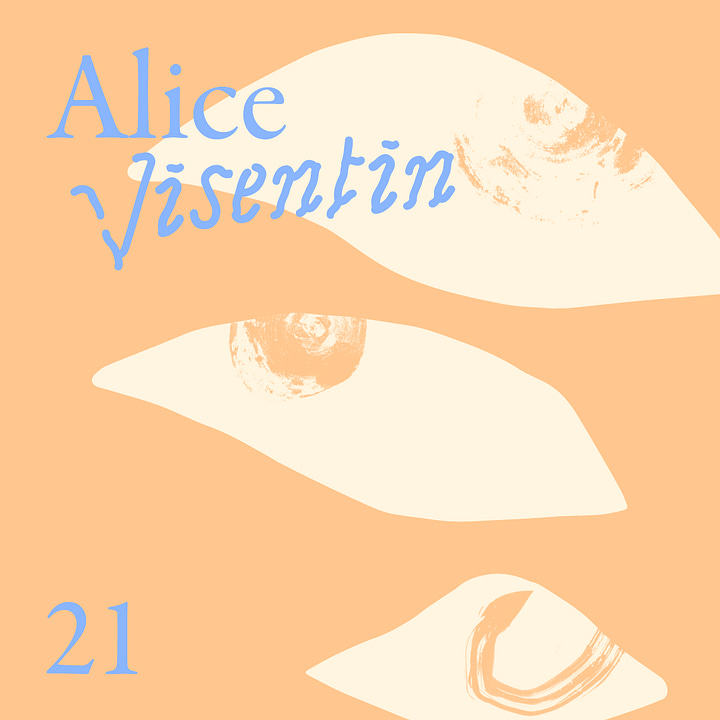

Il tema delle origini e delle memorie spensierate di infanzia è evocato nelle opere di Marta Jorio, Giulia Tudori e Luca Bretani, a fianco allo sguardo evocativo e lirico delle sculture di Giulia Maria Belli, Giulia Milos, Clara Holt e Chiara Zoppei dello studio Zakira Lab, narratrici di miti, leggende e metamorfosi.






Leggerezza, ironia e introspezione sono invece al centro della poetica di Martina Vanda e Valeria Montemagni, fondatrice di Volcanic DreaM, artiste che coniugano con freschezza la semplicità e profondità del quotidiano. Con Marta Vino si allarga maggiormente lo sguardo perché, pur non essendo un’illustratrice di professione, vanta una spiccata dote di sintesi, una capacità di ricondurre all’essenza tipica di chi trasforma storie in immagini, restituendo opere pregne di mito e simbologia.




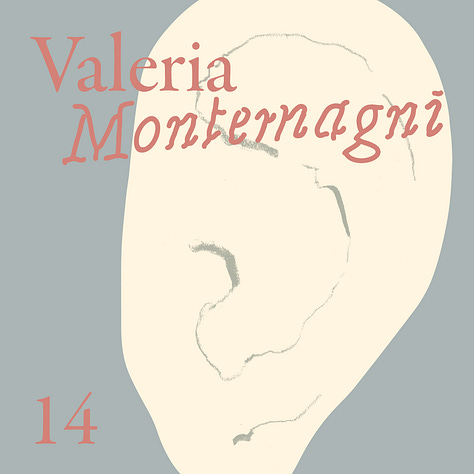

Questa mostra vuole quindi sancire l’unione spirituale tra due discipline attraverso lo sguardo di una nuova generazione di artisti che annoverano la ceramica tra i propri mezzi espressivi, che ci dimostrano ancora una volta che la ceramica è un mezzo intramontabile, che sa rinnovarsi continuamente e che può conferire forza alla narrazione per immagini.
Vi aspettiamo quindi sabato 24 agosto in piazza Martiri della Libertà alle 16:30 per il taglio del nastro della mostra generale e a seguire fino alle 20 per l’ingresso in tutte le mostre.
Carta Cristallina si trova a Palazzo Botton, in piazza Marconi 1.
Per chi viene in treno, da Torino c’è il diretto per Rivarolo, dove trovate la coincidenza bus per Castellamonte, (circa 50 minuti di viaggio, di media c’è un treno all’ora).
>>>English
Carta Cristallina
Illustration meets ceramics. Group exhibition in the context of the Castellamonte Ceramics Exhibition.
Ceramics is a subject that has been close to my heart since time immemorial: as a young girl, when it came to choosing a course of study, I had no doubts about the ceramics-oriented art institute present in my hometown, Castellamonte.
It is precisely on Castellamonte that I want to dwell today: a small town in the Canavese area less than an hour from Turin and a few minutes from Ivrea (you may have heard of the latter for the Olivetti world or perhaps for the battle of the oranges in the historic carnival).
Castellamonte, known for its ceramic stoves exported all over the world, will soon host the 63rd edition of the Mostra della Ceramica, an international event that brings together works by artists from more than twenty countries.
This year the historic event opens up to the world of illustration; I had the pleasure of working as curator on Carta Cristallina: an exhibition involving twenty-two international illustrators who count ceramics among their means of expression. The graphic and exhibition design aspect was taken care of by the multifaceted designers and planners of Studio Fludd, who returned an eclectic and playful image to the exhibition.
For some time I had noticed that ceramics was the subject of renewed interest especially in the world of illustration. I had become aware that more and more illustrators, often in the background, were producing artifacts of surprising expressiveness and graphic synthesis, as if the change of medium provided them with a freshness and freedom of expression that the daily practice of the profession did not fully allow.
An interesting aspect was the challenge for the artist in using materials other than those to which one is accustomed. The technical limitations that ceramics by its very nature impose, oblige the illustrator to revise his habits: the rules of working with earth, glazes and firing, can provide an opportunity for new experimentation for the draughtsman; from the obstacle can arise approaches that give rise to new stylistic figures.
And then there was the aspect of freshness and innocence in the approach to the medium: ceramics made by illustrators, who generally have professional skills far removed from the technical mastery of artisan potters, often possess an instinctive, archetypal beauty, free for better or worse from the conditioning that technical superstructures impose.
They have that poetry of spontaneity that can be found, for example, in some of the posters of the ‘68 French May: in that context artists, using their imagination and much simpler and more modest means than those of professional printers, created iconic works of extraordinary graphic synthesis.
Prominent artists and illustrators, working with major Italian publishing houses or for international magazines and newspapers such as The New Yorker or The New York Times, stand out among the participants: Mar Hernadez, Sarah Mazzetti, Anna Resmini, Alberto Fiocco, and Elena Xausa, an eclectic artist with an essential sign who passed away prematurely and whom we want to remember in this exhibition (I take this opportunity to recommend that you go peek at the Pigrotto, a land-art sculpture that Lorenzo Fonda, Elena's husband, had made through a very participatory crowdfunfing in her memory).
Among the international guests appears Galician Nuria Figueiredo, with her ode to nature, symbolism and mystery, Portuguese artists Mariana Santos, aka Mariana a Miseravel, Constança Duarte and Franpancispiscapa, with their fresh and ironic gaze, all represented by O! Galeria, based in Porto. Then we find Spanish collective Boira Ceramics, Venezuelan Cristina Sitja Rubio, author of several illustrated books published in several countries, and Bolivian Tami Izko, who has taken part in international fairs such as Artissima or the Istanbul Biennial and presents here with multidisciplinary artist Caterina Gabelli a project with organic design and vibrant textures.
We then find in the exhibition the work of Alice Visentin, an artist from Castellamonte who recovers and elevates the spirit of the storytellers of yesteryear, exploring the theme of peasant rituals in the Canavese valleys and who now figures among the artists in the Permanent Collection of the Castello di Rivoli Museum of Contemporary Art.
The theme of origins and carefree memories of childhood is evoked in the works of Marta Jorio, Giulia Tudori and Luca Bretani, alongside the evocative and lyrical gaze of sculptures by Giulia Maria Belli, Giulia Milos, Clara Holt and Chiara Zoppei of Zakira Lab studio, narrators of myths, legends and metamorphosis.
Lightness, irony and introspection, on the other hand, are at the center of the poetics of Martina Vanda and Valeria Montemagni, founder of Volcanic DreaM, artists who combine the simplicity and depth of everyday life with freshness. With Marta Vino the gaze is widened more because, although she is not an illustrator by profession, she boasts a marked talent for synthesis, an ability to lead back to the essence typical of those who transform stories into images, returning works full of myth and symbolism.
This exhibition thus aims to enshrine the spiritual union between two disciplines through the gaze of a new generation of artists who count ceramics among their means of expression, who show us once again that ceramics is a timeless medium that can continuously renew itself and that can lend strength to storytelling through images.
We look forward to seeing you on Saturday, August 24 at piazza Martiri della libertà at 4:30 p.m. for the ribbon-cutting ceremony of the general exhibition and following until 8 p.m. for admission to all exhibitions.
Carta Cristallina is located in Palazzo Botton, Piazza Marconi 1.
For those coming by train, there is a direct from Turin to Rivarolo, where you will find the connecting bus to Castellamonte, (about a 50-minute trip, on average there is one train per hour).




